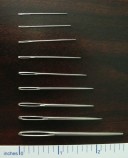Needles for the Canvas
Needlepoint or tapestry needles come with a blunt point and a large eye. The blunt end is for easy stitching since the needle must pass through stitches without splitting them. Sharp pointed needles, such as Chenille, tend to split the canvas. They can pass the thread through but the stitches are not sharp and clear. If you use a sharp needle such as a Chenille needle, you will be constantly pricking fingers. It is very hard to be rid of blood stains on stitches.
The sizes range from 13 to 24. Higher numbers indicate smaller needles. Size 22-24 is for petit point; 17-20 for gros point and 13-15 for quick point. (See Canvas)
The size of the needle is determined by the size of canvas you are using. You want a size that will pass through without pulling hard. If the needle is too large, holes in the work will be apparent. Not only holes but, it distorts the grid easily. If the needle is too small, the thread will wear in spots and will need to be replaced before you have stitched the thread. To decide the correct size, drop a needle into a hole on the canvas. The needle should fall until it has reached the eye where it will stop. A gentle tug on the needle will show if it is the proper size for your canvas. If the needle needs a tug in order for it to pass through, the eye will distort the grid and as a result, the stitches will be uneven and lumpy. Blocking will not correct these problems.
When purchasing needles, it is best to buy higher quality ones. These should be rounded and polished. Gold eyes and a silver tone shanks indicate good needles. The best tapestry needles are from England. When purchasing, they will come in a package with several needles, depending on their size. Very large needles may have only two in the package. Smaller ones may have a dozen.
The eye should be a bit larger than the thread, for two reasons: the thread can fray and the thread passes more smoothly through the canvas. Never use needles that are rusty. They should be kept in a moisture proof container or in wool felt. If your needle tarnishes, this is due to the acid in your skin. To remove tarnish, use a product on the market called "acid mantle" which can be found in a local drug store. Another way to clean it is with an emery filled strawberry which hangs on your tomato pin cushion. If you don't have emery, steel wool works great.
Platinum needles will not tarnish. Needles cost little to buy and good quality tapestry needles bring more pleasure in your work. Remember, "a dull needle worketh a worried stitch."
At times, a sharp needle may be required when stitching beads, chains or other "found" items. When working “Unicorn in Captivity", silk pearl thread was used for flowers stitched in French Knots. A blunt needle could never do the job. A sharp point was required to "cut" through the piles of threads.
When choosing the number needle for the correct mesh, compare the chart Canvas Sizes and Needles.






